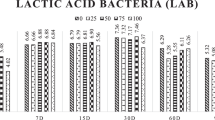Abstract
The goal of the investigations was to determine the boundary conditions of compactness and hermetic level of covering material (permeability of the covering material) to inhibit mould growth during silage storage. The influence of air exclusion on fermentation quality, mould growth and mycotoxin content in the silage should be tested. To get a sufficient fermentation quality, as well as an inhibition of mould growth in the silages, necessary boundary conditions of air exclusion were: a compactness of at least 200–210 kg/DM m3 and a maximum permeability of the covering material of 1,7 l/m2 in 24 hours (six numbers of wraps of the used ensiling stretch film). Summarised, the measured amounts of <1,0 mg roquefortine C/kg in the silages is considered to be relatively low. Within the actual state of knowledge of toxicology, it is not considered dangerous to feed ruminat animals with silages containing these low amounts of roquefortin C.
Similar content being viewed by others
Literatur
Zimmer E (1990) Grünlandbewirtschaftung. In: Extensive Grünlandbewirtschaftung durch Tierhaltung. KTBL-Arbeitsblätter 140, Darmstadt, 7–21
Knauer N (1993) Beweidung mit Nutztieren. Neue Landwirtschaft, 2: 64–66
Prochnow A. (1994) Verfahrenstechnische Grundlagen für die Landschaftspflege am Beispiel der Nuthe-Nieplitz-Niederung. Diss. HUB
Kaiser E, Zimmer J, Schmerbauch K (1994) Bedeutung des Nitratgehaltes im Mähgut für die Frischverfütterung und Konservierung des Materials- Erste Ergebnisse zur Silierung extensiv erzeugten Grünfutters. In: Technik und Verfahren zur Landschaftspflege und für die Verwendung der anfallenden Materialien. VDI/MEG-Kolloquium Agrartechnik, Bornim, 17: 196–205
Weissbach F, Honig H (1996) Über die Vorhersage und Steuerung des Gärverlaufes bei der Silierung von Grünfutter aus extensivem Anbau. Landbauforschung Völkenrode 46: 10–17
Armbruster G (1994) Futterhygienische Untersuchungen von Silagen. Nachweis und Vorkommen des Mykotoxins Roquefortin. Diss. LMU München.
Weissbach F, Honig H (1992) Ein neuer Schlüssel zur Beurteilung der Gärqualität von Silagen auf der Basis chemischer Analysen. 104. VDLUFA- Kongress, Gießen, Kongressband, 489–494
Weissbach F, Honig H (1997) Vorschlag für einen neuern Schlüssel zur Beurteilung der Gärqualität von Grünfuttersilagen auf der Basis chemischer Untersuchung. 38. Interne Sitzung des DLG-Ausschusses für Futterkonservierung am 02.07.1997 in Gumpenstein
Gedeck B (1973) Futtermittelverderb durch Bakterien und Pilze und seine nachteiligen Folgen. Übers. Tierern. 1: 45–56
Author information
Authors and Affiliations
Rights and permissions
About this article
Cite this article
Idler, C., Schmerbauch, K.J. Roquefortin-C in Silagen aus Landschaftspflegegut. Mycotox Res 17 (Suppl 2), 238–241 (2001). https://doi.org/10.1007/BF03036444
Issue Date:
DOI: https://doi.org/10.1007/BF03036444




